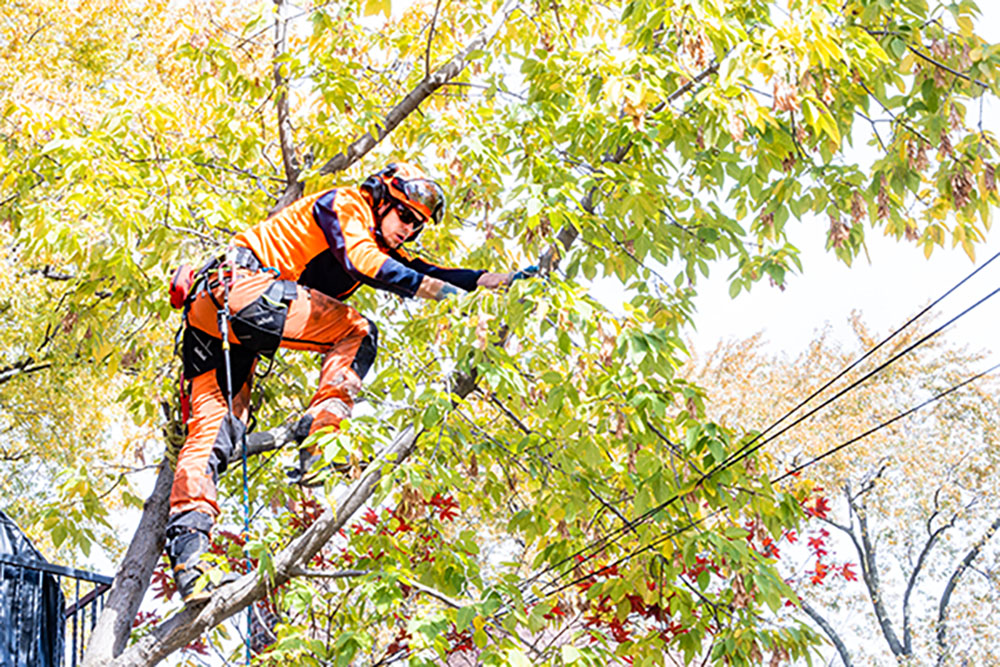
Living wage employers
Horticulture businesses discover investing more in staff pays dividends
BY JORDAN WHITEHOUSE
PHOTOS BY KARINA SINCLAIR
When Scott Gardner started working at Toronto’s Vista Tree Management last year, he was making just under $24 an hour. Now the arborist apprentice is up to almost $25, and that will likely go up again soon. Compared to his last job, it’s a big boost to his income. Gardner says that increase has made a big difference in his quality of life.
“It’s just a lot less stress when I’m away from work,” says Gardner. “Having that living wage means that I can be confident that the bills are going to get paid, and that makes it a lot easier to come into work and enjoy my time when I’m not at work. And when you’re happier, I feel you’re a better employee.”
Gardner is one of an increasing number of Canadian workers earning what’s called a living wage*. It’s the minimum hourly wage a worker needs to cover the actual costs of living in their community. In Metro Vancouver, for instance, the living wage amount is $20.52, while in Kelowna, B.C., it’s $18.49. In Toronto, it’s $22.08, while in Kingston, Ont., it’s $17.75.
 James May, Vista Tree co-owner; Jake Gardner, arborist apprentice; Scott Gardner, arborist apprentice.
James May, Vista Tree co-owner; Jake Gardner, arborist apprentice; Scott Gardner, arborist apprentice.
The numbers are calculated using a framework developed by the Canadian Centre for Policy Alternatives. They’re based on a two-parent family with two kids, and typically take into account food, clothing, rental housing, childcare, transportation, and a small savings. They don’t consider things like retirement savings, debt repayment, or home ownership, but they do reflect inflation.
There aren’t any official stats on the growth of living wage employers in Canada, let alone in the landscaping industry, but in recent years a few certifying bodies have popped up in British Columbia, Alberta and Ontario. They make sure certified employers continue to pay workers the living wage in their region.
At the time of writing, there were 17 gardening and landscaping companies listed with B.C.’s certifying body, Living Wage for Families BC, and 13 landscape contractors listed with the Ontario Living Wage Network.
Other companies are also stepping up their wages, even if not currently certified. Vista Tree Management is one (though they do expect to be certified soon). When co-owners and tree care industry vets Michal Kenins and James May launched their company in April 2021, they told themselves they wouldn’t enrich themselves at the expense of their employees.
Kenins says he started off in the industry being paid $18 an hour in Toronto, which was “so punishing and difficult.” Never again for themselves or someone else working for them, they pledged. “If [our employees] are working in the city of Toronto, they need to be able to live in the city of Toronto, and that includes raising families here,” says Kenins.
Like Vista Tree, Vancouver’s Craine Projects saw the logic in introducing living wages in one of the continent’s most expensive cities. But the choice also had a lot to do with living up to the values they tout to employees and the public.
Kelly-Ann Racich is Craine’s marketing and communications rep, and she says her bosses had never heard of living wages before they started bidding for landscaping contracts with the City of Vancouver a few years ago. One of the recommendations before applying is to be a living wage employer.
“So, when they looked into it, they thought, ‘You know, not only will this help us get city contracts, but it really is aligned with our values. We’re founded on integrity, and if we’re not taking care of and supporting the people who make our company what it is, then how can we claim that?’” says Racich.
 Craine Projects, a full service landscape design and build company based in Vancouver, B.C., is a certified living wage employer. — Supplied photo
Craine Projects, a full service landscape design and build company based in Vancouver, B.C., is a certified living wage employer. — Supplied photo
For a similar reasons, Toronto’s Gardenzilla is going through the living wage certification process right now. During non-pandemic times, owner Michael Chudy usually takes all of his employees out for breakfast once a month to talk about what’s happening at the company and what might make it a better place for them to work. Ideas like health benefits and living wages have come out of those chats, and the company is now acting on both.
“Lots of people come into this industry, and lots of people leave, and I know how hard that is for companies,” says Chudy. “So, the goal here was to be a place where people want to stay and where when you work here, you feel like you can actually build a career and you can actually stay here and raise a family and do all these things that we all want to do to varying degrees.”
Chudy learned the importance of that lesson at his last job, where he was the director of operations at a landscaping company. Along with hosting big staff parties and other morale boosters, he helped increase staff wages. It didn’t take long for the company to see increases in profits and efficiency, he says. “It really supported this idea that by investing in the people who work with your company, both they and the company benefit.”
Other than ethics, recruitment and retention are two of the main reasons why the employers we spoke to for this story adopted living wage programs. Take Surrey, B.C.’s Atkinson Landscaping, which became living wage certified a couple of years ago. “We also have a few other things that help with the retainment of people — like profit-sharing programs — but for sure having a living wage being slightly above probably what competitors are paying is really helpful for retaining staff,” says co-owner and GM David Endacott.
At Vista Tree, Michal Kenins says they have more people applying to their company than they even anticipated. In other words, he’s not seeing the same skills shortages others are. “I’d say there’s not just a skills mismatch out there — there’s an expectation mismatch in terms of what workers are looking for and what’s actually being offered.”
As good as living wages are for recruitment and retention, it can’t just be about recruitment and retention, says Kenins. “If it’s just about that, you’re probably going to find that it’s very difficult for you to emotionally deal with the struggle that comes from changing your finances around to support it.”
And it can be a financial struggle, says Kenins. For Vista Tree, living wages have been in place since day one, so it’s all the company has known. But it has meant lower potential profits and higher end pricing. Both are okay with Kenins, but he knows that’s not true for every company.
 Scott Gardner, an arborist apprentice with Vista Tree Management, works on a jobsite in Toronto in November, 2022.
Scott Gardner, an arborist apprentice with Vista Tree Management, works on a jobsite in Toronto in November, 2022.
Still, there can be a phased approach to this, he says. Maybe a company can’t offer the specific living wage in its area yet, but maybe it can introduce things like health benefits, paid sick days, or other perks. “These types of small changes can really help improve working conditions, and then you’re going to see hopefully a return in terms of your employees’ commitment, and the value that they see in the company,” says Kenins.
David Endacott agrees that even if it’s not possible to offer living wages right now, it’s a solid goal to work toward. He’s quick to point out that even with living wages in place, it can still be a struggle for people to make ends meet in places with sky-high costs of living like the lower mainland of B.C. That’s why he isn’t always comfortable promoting Atkinson Landscaping as a living wage employer. “It’s a tough dynamic to manage, but I think it should always be the goal of any business to pay their staff an amount they can live off of.”
At Gardenzilla, where almost all staff are already earning what would qualify as a living wage, there isn’t really a financial challenge with becoming certified. Instead, the challenge will be making sure the entire team continues to feel valued and that they are properly rewarded for their work, says Chudy. “If you want to compete in this industry, and if you want to attract good people, you have to pay them a fair living wage in order for them to want to work with you. That just makes sense.”
Staying competitive means staying committed to your people, says Kenins. “The benefit of having the living wage is that we’ve been able to sort of pick and choose the people who have chosen us. And those we’ve chosen have stayed and allowed us to deliver the type of customer service and quality of care that meets the needs of clients who are paying the higher amounts that allow us to prosper.”
The reason Scott Gardner has stayed at Vista Tree and tried to provide that service is pretty simple. “When they want the best for you, you want the best for them right back.
*Living wages listed are based on information as of November 2022.